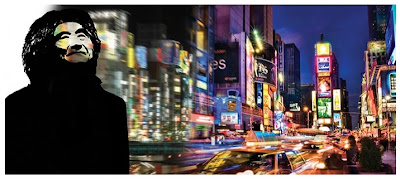 |
| Manga and anime can color classroom doldrums. Via. |
The influence of anime and manga (Japanese animated films and comic books respectively) in America has grown beyond its cult status of the last decades of the 20th century.
Anime conventions in the U.S. draw thousands of participants rocking out in costume and taking part in readings, demos, panels, collecting, workshops and screenings. Major chain book retailers like Borders and Barnes & Noble have shelves of manga, and our traditional comic book stores are filled to the brim with Japanese imports.The rise of manga and anime as entertainment in the U.S. is ever growing, but there’s another area where it increasingly brings people together and makes a difference:
The classroom.
When I attended Japanese high school, the only manga I saw in class was sneakily hidden behind my friend’s textbooks during the occasional boring lesson. These days manga serves as a teaching tool to provide a fun and interactive way to expose American students to art, social sciences and foreign culture.
"For teachers of Japanese Studies, Asian Studies, or any kind of diversity studies, the rising popularity of anime and manga among young North Americans seems an opportunity too good to miss," writes Toni Levi, in her excellent essay "
Anime & Manga: It's Not All Make-Believe" at our
About Japan teachers website. Levi discusses introducing the material to students:
There are basically three ways to approach anime and manga in the classroom: 1) to focus on the content using approaches drawn from the social sciences, 2) to focus on the content using analytical methods drawn from literary and dramatic criticism, and 3) to focus on the anime or manga as a cultural document in its own right. Each of these has something different to offer and all in all, this is a great way to bring exciting, entertaining, and culturally relevant works into the American classroom.
Various manga and anime have Japanese cultural references that can enlighten American children about foreign customs. For example, the classic Hayao Miyazaki children’s film,
My Neighbor Totoro has a scene where the father takes a bath at night with his two children illustrating the importance of bath culture in Japan. Much manga and anime contains great coming-of-age stories suitable for young adults or teenagers. English teachers may like to know that there are also many references to old forms of Japanese storytelling such as
kamishibai,
bunraku and
kabuki, whose influence is clearly seen in modern works literature.
On November 8 & 10, the Japan Society
Education Program presents the two-session workshop
What’s With Japanese Comics?: Bringing Manga Into the Classroom, introducing educators to the art of manga and anime and how to utilize them as powerful teaching tools.
The November 8 session features Brian Camp, Programming Manager for
CUNY TV and co-author of
Anime Classics Zettai! 100 Must-See Japanese Animation Masterpieces. He introduces seminal works and themes as well as Japanese concepts of storytelling with special attention to popular animated cartoon shows that have sprung from manga. He'll discuss sources of manga’s appeal to American readers today, showing how trends in the comic book genre in the U.S. from the 60s-90s reflects what's happening today with manga, using the recent explosion of
shoujo (girls’) manga as an example.
November 10 features artist and professional
mangaka (comic book illustrator)
Hiroki Otsuaka, who created the original manga
Samurai Beam for our spring 2010 Kuniyoshi exhibit. Otsuka introduces manga from the creative side, and shows participants how to turn themselves into a manga character and create a manga-esque storyline from their life.
Because the classics are as valuable as modern fare to inspire learning, the Education Program recently wrapped up a sister-workshop called
Integrating Art and Social Studies Using Paintings by Zen Master Hakuin, showing how Hakuin's lessons towards enlightenment can enrich a child’s educational experience. K-12 educators took a guided tour of
The Sound of One Hand: Paintings and Calligraphy by Zen Master Hakuin and collaborated to create teaching ideas and materials to bring back to their classrooms.
According to Education Program staff, the workshop cleared up a number of misconceptions about Zen (a Google search for “zen” brings up an insane amount confusion), outlining three basic characteristics: the master/disciple relationship; opposition to the use of idols; and meditation on
koans, "verbal paradoxes with no answers aimed at encouraging unorthodox approaches to self-reflection by the Zen believer," according to presenter Frank Felten. They discussed the simple formula of the "3 Hakuins": the playful Hakuin + the serious Hakuin = Hakuin the Zen monk, and Felton outlined Hakuin's major themes:
Hakuin chose themes that were in some way or another directly related to himself. Supreme deities (Kannon/Avalokitesvara), sages that he admired or that interested him (Hotei, Yen t’ou), everyday objects as an important part of religious practice, elements of folk belief that he was accustomed to and that he considered an important part in life, calligraphy.
Concluding the workshop,
Linda Mulhauser led a sumi ink painting lesson, where participants had a lot of fun working the brush and discovering that bamboo looks deceptively simple to paint. We're lucky to have Linda return November 21, to lead a
sumi ink painting workshop for children ages 8-12.
T.D.
























